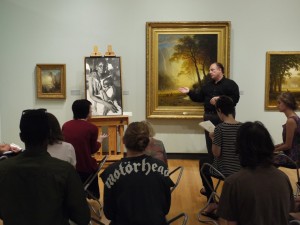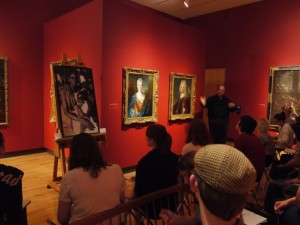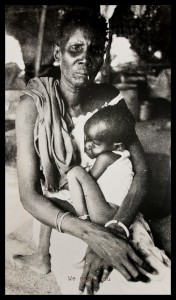The Dense Image was developed in conjunction with the Institute for Curatorial Practice at Hampshire College (June 1 – July 3, 2014) which included three weeks of curatorial theory and exhibition history and two weeks of conceptual mapping, essay writing, and web design. Adrian Piper’s Ur-Mutter #2 (1989), part of Mount Holyoke College Art Museum’s collection, was the foundational image for our curatorial process. Derived from themes uncovered in Adrian Piper’s work, The Dense Image functions as a network of images, sources, and flows of information that complicate the artistic and curatorial practice of appropriation.
Adrian Piper’s Ur-Mutter #2
“The Pied Piper”
 In a workshop for the Institute for Curatorial Practice lead by John R. Stomberg, the Florence Finch Abbott Director and Lecturer in Art at Mount Holyoke College Art Museum, Ur-Mutter #2 was taken through the galleries of the permanent collection. In each room, the group stopped to discuss Adrian Piper’s work in relation to the themes of the gallery. Each time, new information was generated as we rewrote Piper’s work into the new gallery context.
In a workshop for the Institute for Curatorial Practice lead by John R. Stomberg, the Florence Finch Abbott Director and Lecturer in Art at Mount Holyoke College Art Museum, Ur-Mutter #2 was taken through the galleries of the permanent collection. In each room, the group stopped to discuss Adrian Piper’s work in relation to the themes of the gallery. Each time, new information was generated as we rewrote Piper’s work into the new gallery context.

Just as Ur-Mutter #2 was physically ushered from gallery to gallery, context to context, its life as a digital image presents an endless potential for (re)contextualization. Through the drag and drop process, the image stretches itself through digital space. Its context transcends the artist’s intentions and the curatorial thesis, as its meaning is both imploded and expanded, its borders opened, and its appropriative nature perpetuated.
The Digital Space
In line with the generative nature of Ur-Mutter #2, it is important to acknowledge that this exhibition furthers the appropriative process and does not lead the image to a second stand still. The digital platform promotes the appropriative/appropriated nature of Ur-Mutter #2 by inserting the work into another complex, networked system. The Dense Image is only one of its many locations on the web.
In creating the website, we saw code and coding as entirely practical, a tool for projecting our concept onto the web unconnected to our concept. Our initial understanding was that the tools at our disposal were not unlike lumber, nails, hammers and screws that are used to build a house. A designer has a vision, aesthetic, functional, structural etc., and those tools and materials facilitate the realization of that. However, through numerous conversations, and experiences, the tool metaphor began to break down. Even in website building, it is not about the single object, the unique piece: it is about a concept which can be logged into. We discovered that website construction is fundamentally appropriative. Designers investigate the code and structures of websites for inspiration and solutions. Students of coding break designs to fix and reconfigure them. The language and tools of HTML and CSS evolve according to those new appropriative attempts to devise work arounds for the limitations of the code. In light of these facts we recognize web design as an appropriative act and generative in the same way that the production of these artworks and curating are.
The Dense Image
Special thanks to: Museums 10, The Institute for Curatorial Practice, Eric Peterson and all Five Colleges instructors and staff for making this possible.
